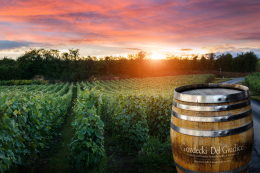A Necessary Pairing: The Wine Industry and Intellectual Property Protection

Considering the specifics of the wine industry, a tailored approach to trademark searching, trademark prosecution, enforcement, and anti-counterfeiting endeavors, along with a robust process for regulatory compliance, is necessary to leverage the success of a wine producer’s trademark assets and goodwill.
Searching
Conducting trademark searches greatly reduces the risk of adopting an infringing mark. The following features of the wine industry elevate the importance of searching in the trademark process.
- The cost to pull infringing wine bottles off the shelf is significant. Wasting an especially good year of premium grapes or other favorable conditions due to the selection of an infringing mark could be catastrophic.
- The wine field is very crowded, with lots of competitors and lots of outlets that sell wines.
- Distribution agreements may include representations and warranties asserting that a mark is non-infringing.
Geographic Indicators and Appellations of Origin
Trademark law, both in the United States and internationally, protects geographic marks that certify that a particular product is from a particular region and meets other agreed upon standards. For wine, Geographic Indicators (GIs) are prominently placed on the label and are significant selling points for consumers.- Appellations of Origin -- Appellations of Origin are a subset of GIs that certify that a product not only comes from a particular region but also shares a characteristic from the environment of that region. Viticultural Areas and state or county geographic designations are types of appellations and have similar but differing standards as to when they can be used.
- Viticultural Areas -- Viticultural Areas are granted upon petition by either wineries or other interested parties and are regulated by the Alcohol and Tobacco Tax and Trade Bureau (TTB), a subset of the Department of the Treasury. For a wine to use the name of a Viticultural Area, it must contain at least 85% of grapes from the area, in addition to being finished in the state or one of the states in which the Viticultural Area is located.
- State and County Appellations of Origin -- Adopted prior to Viticultural areas, these are still in force today, and requirements differ for each. However, all of the approved state and county designations require at least 75% of grapes to have been grown in the covered geographic area, and that the wine is finished in the state in which the geographic area is located. Some designations are much more stringent. For example, California wines require that 100% of the grapes must be produced there.
Trademark Filing
If a mark is clear after a search, and all regulatory requirements for a label are otherwise satisfied, filing for trademark registration is recommended for the product name chosen for the wine. Below are some key considerations regarding trademark filings in the wine industry.- Trademark registration is required to register a mark with US Customs, which aids anti-counterfeiting efforts.
- Trademark registration is required to bring a counterfeiting claim against a third party.
- Only one trademark can be protected per trademark application. If a wine label as a whole is the subject of a trademark application, it may be refused as containing multiple trademarks.
- Appellations of origin or other certification marks owned by third parties must be removed from the drawing of a mark submitted to the USPTO.
- Trademark protection enhances the value of an asset.
Counterfeiting and Enforcement
Trademark infringement and especially counterfeiting are large problems in the wine industry, and it is the responsibility of a trademark owner to enforce their rights. Counterfeiters can re-cork used bottles of high-end wine filled with counterfeit product and sell them through a variety of channels worldwide. This process has fooled even sophisticated collectors.Wine industry participants can be vigilant in looking for counterfeit wine by doing the following:
- Monitoring the trademark offices of various countries for infringing trademarks;
- Periodically reviewing regulatory databases for companies attempting to manufacture, produce, or export counterfeit wine;
- Conducting periodic checks of e-commerce sites, such as eBay, for listings that are suspicious;
- Monitoring the major auction houses that sell high-end collectible wine, especially ones that offer online auctions; and
- For producers, making sure that a system of quality control and tracking is in place that allows each bottle of wine to be traced back to its source at each stage of the supply chain.
Along with the many legal considerations faced by the wine industry, intellectual property protection is of paramount importance. Companies that are pro-active and vigilant about trademark clearance, registration, and monitoring are able to more effectively and efficiently enforce their rights and add value to their brands in the process.
This article is intended to provide general information regarding the topic addressed and is not intended to constitute legal advice regarding specific issues and should not be relied upon as such. Please contact attorney Daniel D. Lano of Gozdecki, Del Giudice, Americus & Brocato LLP for any assistance with trademark clearance, prosecution, and/or enforcement.

